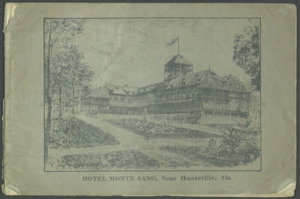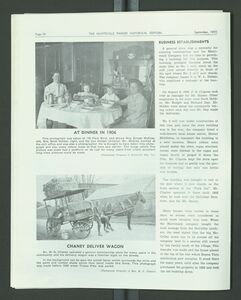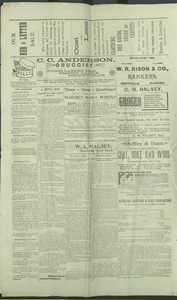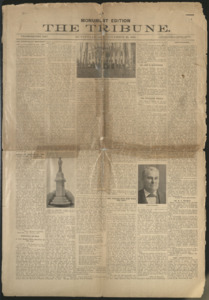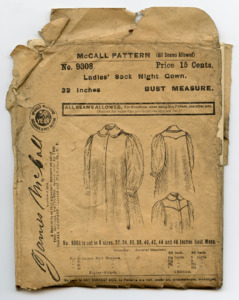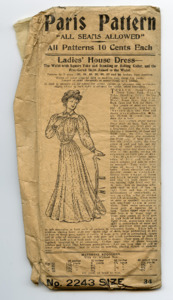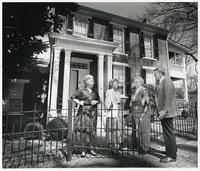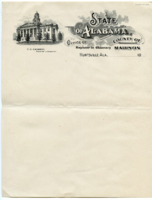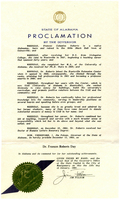
Browse Items (56 total)
Sort by:
-
"HOTEL MONTE SANO, Near Huntsville, Ala."
This pamphlet announces the opening of the Hotel Monte Sano on June 1, 1887 and lists the manager as "Mr. S.E. Bates." The first section of the pamphlet includes a brief history of Huntsville and a description of the city's amenities. The author extolls the health advantages of Huntsville as "most healthfully situated at the base of Monte Sano" and describes the city's lack of recent disease outbreaks. The second section of the pamphlet details the Hotel Monte Sano's furnishings and amenities. The author emphasizes the "healthful" environs of the mountain and the hotel and includes letters from Huntsville's "eminent physicians" as testimonials. The pamphlet includes illustrations of scenes from Huntsville and Monte Sano. -
Chaney Delivery Wagon in Huntsville Parker article, 1955.
This is an image of page 20 from The Huntsville Parker Historical Edition from September 1955. The Huntsville Parker was the Merrimack Manufacturing Company's newspaper in Huntsville, Alabama. This page is titled "Business Establishments" and the images featured are titled "At Dinner in 1906" and "Chaney Deliver Wagon." The article on this page is about the history of the general store in Merrimack Mill Village. -
W.L. Halsey and C.H. Halsey grocery store advertisements, 1896.
This is an image of page six of the Weekly Mercury from July 1896. W.L. Halsey and C.H. Halsey advertisements for their grocery stores are featured on this page. Other advertisements on this page include "C.C. Anderson Druggist", "W.R. Rison & Co. Bankers", "Sheffey & Dean", and "Herstein & Lowenthal, Proprietors." -
The Tribune, Monument Edition.
Published on Thanksgiving Day 1900, this issue of the Tribune includes stories, songs, and poetry; lists of dead Confederate soldiers from Huntsville and Madison Count; and coverage of the erection of the Confederate monument in downtown Huntsville. Much discussion is made as well of the "Lost Cause," a mythology that perpetuates the belief that the cause of the Confederate States was noble and just and denies that slavery played the central role in secession. Includes columns written by Virginia Clay-Clopton and John Tyler Morgan. -
McCall Pattern no. 9308, Ladies' Sack Night Gown.
Made for a size 32-inch bust, this nightgown pattern includes five pieces for the front, back, collar, sleeve, and sleeveband. The pattern does not include pieces for the yoke. The front of the pattern envelope lists the material required for each size, and the back describes garment construction. The pattern pieces are unprinted. -
Paris Pattern no. 2243, Ladies' House Dress.
Made for a size 34-inch bust, this house dress pattern includes pieces for "The Waist with Square Yoke and Standing or Rolling Collar, and the Five-Gored Skirt Joined to the Waist." The front of the pattern envelope lists all instructions for the construction of the garment as well as material required. The pattern pieces are unprinted. -
"Frances Cabaniss Roberts: Her Life and Legacy."
This virtual talk includes a lecture from Dr. Tom Reidy, editor of the 2020 edition of Frances Roberts' 1956 dissertation, with comments and moderation by UAH Head of Archives and Special Collections Reagan Grimsley and History Department Chair Stephen Waring. The talk was given as part of an Alabama Humanities Alliance grant, in partnership with the UAH M. Louis Salmon Library, the UAH Humanities Center, and the UAH History Department. -
Proclamation from Gov. Jim Folsom announcing December 12, 1993 as Dr. Frances Roberts Day.
Folsom issued the proclamation on the same day that Roberts received an honorary doctorate from the University of Alabama in Huntsville. The text of the proclamation commends Roberts' service to the university and the community, noting that "Dr. Roberts combined her job of teaching, research and service with a much broader sense of responsibility which led her to do above and beyond what she was asked."
